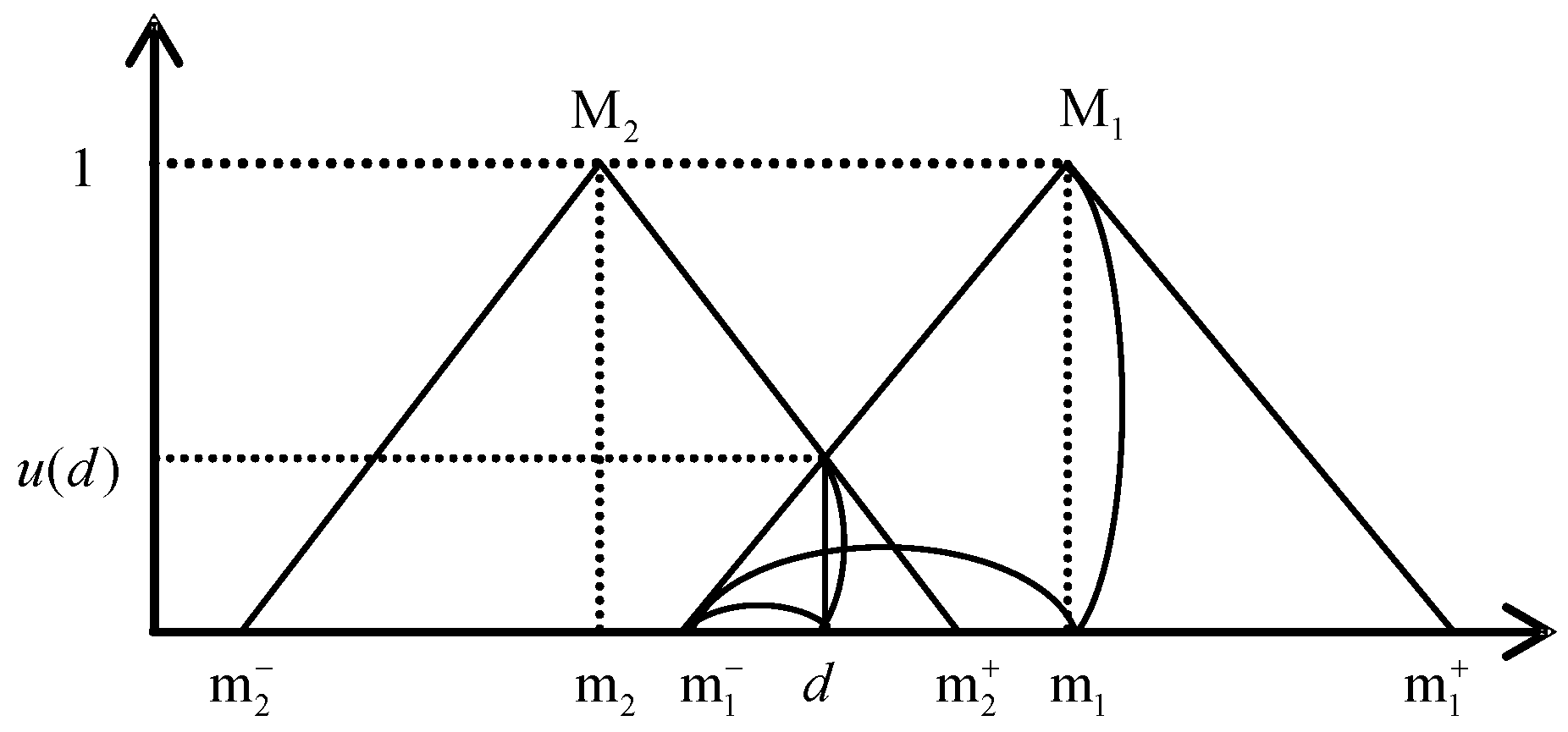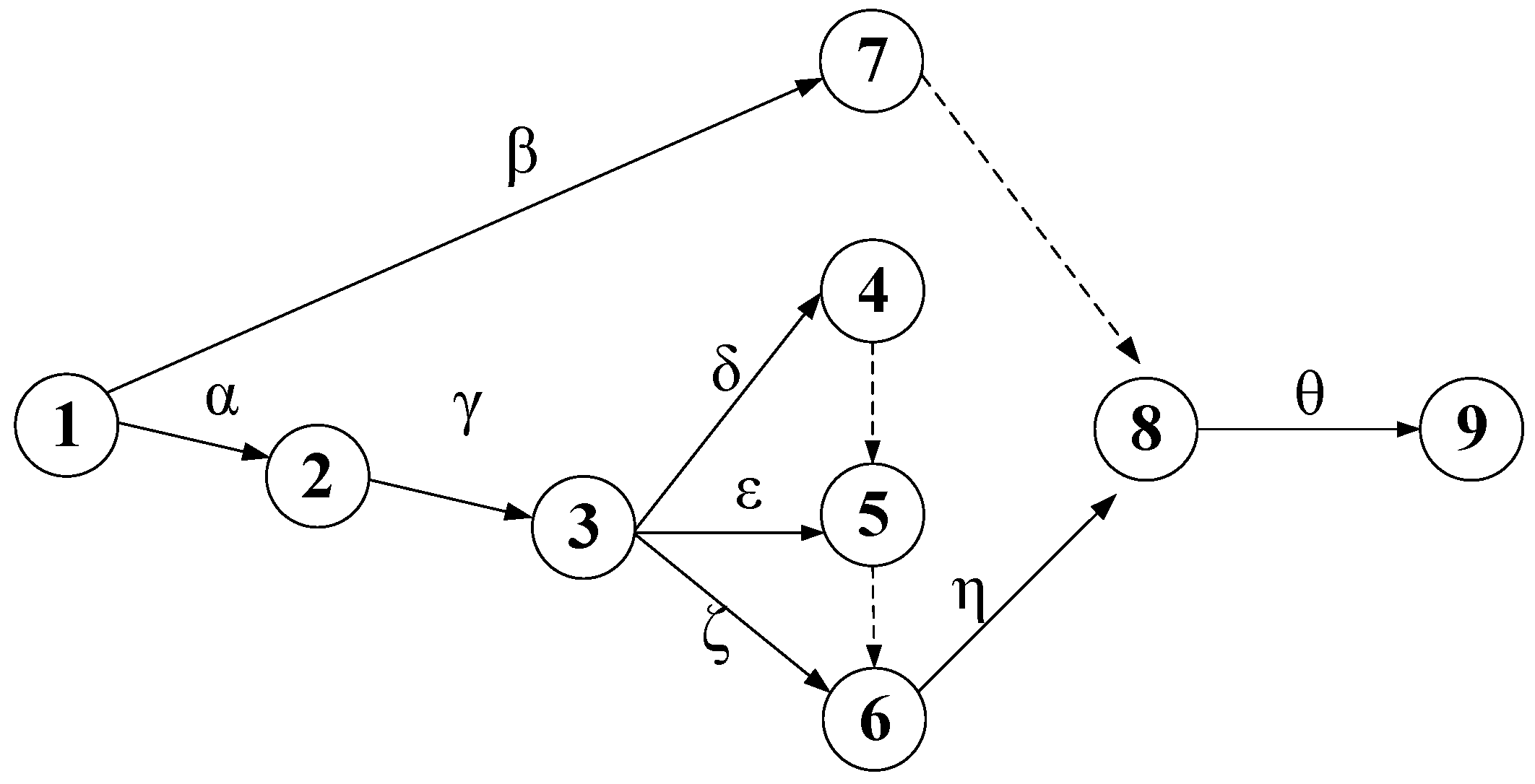In recent years, project management methods, such as CPM and PERT, have evolved to better tackle real-world problems. Fuzzy set theory is often applied to deal with the incompleteness or unavailability of information needed to approach problems. Chanas and Zieliński [
7] performed a critical path analysis in the network when activity times are fuzzy in nature. Two methods were proposed to calculate the path degree of criticality. The first one was for activity times with fuzziness in general form, and the second one was for activity times with fuzzy numbers of the L-L type. Chen and Chang [
8] constructed a fuzzy PERT algorithm, where a fuzzy number was used to represent the duration time of each activity. The proposed algorithm could find multiple possible critical paths in a fuzzy project network. Dubois et al. [
9] performed an extensive overview of fuzzy set-based approaches to scheduling. They studied fuzzy PERT, which considers incomplete information, and changes the probability distributions of activity durations into possibility distributions. Chen and Huang [
10] studied the cycle-time management problem in a supply-chain system and proposed the use of fuzzy PERT to calculate the total fuzzy cycle time of the supply-chain system. Chen and Huang [
11] proposed a fuzzy PERT approach to measure the critical degree of each activity and to find the critical path in a project network. Fuzzy activity time of each activity was considered and was represented by a triangular fuzzy number, and the fuzzy set theory and the PERT technique were incorporated to develop the model. Chen and Hsueh [
12] presented an approach for solving the CPM problem with fuzzy activity times. The problem was formulated as a linear programming model with fuzzy coefficients of the objective function. Yager’s ranking method was then used to transform the fuzzy CPM problem into a crisp problem, which was subsequently solved by conventional streamlined solution methods. Liang [
13] applied the fuzzy set theory and proposed a possibilistic linear programming (PLP) approach to solve multiple objective project management decision problems. The multiple imprecise goals were assumed to have triangular possibility distribution, and the approach was claimed to minimize the total project costs and the completion time simultaneously. Liang [
14] further solved the fuzzy multi-objective project management problem using a two-phase fuzzy goal programming method. Phase I solved the fuzzy multi-objective linear programming problem by applying fuzzy decision-making concepts proposed by previous scholars. Phase II improved the solution by using the satisfaction degree from Phase I as a constraint, and used a compensatory weighted average operator to obtain an overall satisfaction degree. Yakhchali and Ghodsypour [
15] presented a polynomial algorithm to compute latest starting times of activities in interval-valued networks. The algorithm considered fuzzy durations and attempted to minimize time lags. Liang [
16] further solved the project management problems with multiple goals in uncertain environments by proposing a two-phase fuzzy goal programming method. The first phase used the minimum operator method, and the second phase used the weighted average operator method. The method aimed to minimize total project costs, total completion time, and total crashing costs, simultaneously. Chen and Tsai [
17] performed a time–cost tradeoff analysis of project networks under fuzzy environments when the duration times and costs were uncertain. The proposed approach formulated a pair of parametric mathematical programs to find the membership function of the fuzzy minimum total crash cost. Liang et al. [
5] proposed a fuzzy mathematical programming approach for solving the imprecise project management decision problems. Triangular fuzzy number was used to represent the imprecise goal and costs, and the proposed model aimed to minimize the total project costs. Maravas and Pantouvakis [
18] proposed a project cash flow analysis approach when the activity durations and costs were uncertain. Chrysafis and Papadopoulos [
6] proposed an approach for estimating some important factors, such as activity times, float, criticality degree for each activity and for each path, project duration, and probability for project completion time. The approach was based on fuzzy statistics and fuzzy probabilities and could be used when the statistical data for the project activity duration existed. Jeang [
19] first applied response surface methodology (RSM), a statistical analysis method, to solve the time–cost tradeoff problem for project management with a single objective. A multi-objective optimization in project scheduling was then presented to consider multiple objectives—including project budget, completion time, total cost probability, and completion time probability—and compromise programming was used to solve the problem. Creemers et al. [
20] considered the risk of activity failure and the possible pursuit of alternative technologies in the project scheduling problem. A generic model was proposed first to incorporate stochastic durations, non-zero failure probabilities, and modular completion subject to precedence constraints. A dynamic-programming model was constructed next to devise an execution policy to maximize the expected net present value of the project. Yaghoubi et al. [
21] studied the resource allocation in multiclass dynamic PERT networks with finite capacity as Markov processes and proposed a multi-objective model. A simulated annealing (SA) algorithm, which used the goal attainment formulation, was applied to solve the multi-objective problem.








